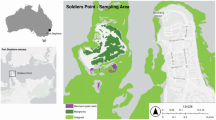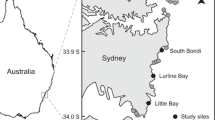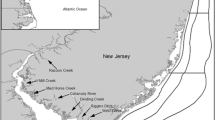Abstract
Large predatory fishes are disproportionately targeted by reef fisheries, but little is known about their trophic ecology, which inhibits understanding of community dynamics and the potential effects of climate change. In this study, stable isotope analyses were used to infer trophic ecology of a guild of large predatory fishes that are targeted by fisheries on the Great Barrier Reef, Australia. Each of four focal predators (Plectropomus leopardus, Plectropomus maculatus, Lethrinus miniatus and Lutjanus carponotatus) was found to have a distinct isotopic signature in terms of δ13C and δ15N. A two-source mixing model (benthic reef-based versus pelagic) indicated that P. leopardus and L. miniatus derive the majority (72 and 62 %, respectively) of their production from planktonic sources, while P. maculatus and L. carponotatus derive the majority (89 and 74 %, respectively) of their production from benthic reef-based sources. This indicates that planktonic production is important for sustaining key species in reef fisheries and highlights the need for a whole-ecosystem approach to fisheries management. Unexpectedly, there was little isotopic niche overlap between three of four focal predators, suggesting that inter-specific competition for prey may be low or absent. δ15Nitrogen indicated that the closely related P. leopardus and P. maculatus are apex predators (trophic level > 4), while δ13C indicated that each species has a different diet and degree of trophic specialisation. In view of these divergent trophic ecologies, each of the four focal predators (and the associated fisheries) are anticipated to be differentially affected by climate-induced disturbances. Thus, the results presented herein provide a useful starting point for precautionary management of exploited predator populations in a changing climate.






Similar content being viewed by others
References
Abrantes K, Sheaves M (2009) Food web structure in a near-pristine mangrove area of the Australian Wet Tropics. Estuar Coast Shelf Sci 82:597–607
Abrantes K, Sheaves M (2010) Use of a δ13C-δ15N relationship to determine animal trophic positions in a tropical Australian estuarine wetland. Austral Ecol 35:96–103
Baker R, Buckland A, Sheaves M (2013) Fish gut content analysis: robust measures of diet composition. Fish and Fisheries (In press) doi:10.1111/faf.12026
Bellwood DR, Hughes TP, Folke C, Nystrom M (2004) Confronting the coral reef crisis. Nature 249:827–833
Blaber SJM, Milton DA, Rawlinson NJF, Tiroba G, Nichols PV (1990) Diets of lagoon fishes of the Solomon Islands: predators of tuna baitfish and trophic effects of baitfishing on the subsistence fishery. Fish Res 8:263–286
Bozec Y, Gascuel D, Kulbicki M (2004) Trophic model of lagoonal communities in a large open atoll (Uvea, Loyalty Islands, New Caledonia). Aquat Living Resour 17:151–162
Bruno JF, Selig ER (2007) Regional decline of coral cover in the Indo-Pacific: timing, extent, and subregional comparisons. PLoS One e711:1-8
Cappo M, De’ath G, Speare P (2007) Inter-reef vertebrate communities on the great barrier reef marine park determined by baited remote underwater video stations. Mar Ecol Prog Ser 350:209–221
Choat JH (1991) The biology of herbivorous fishes on coral reefs. In: Sale PF (ed) The ecology of fishes on coral reefs. Academic Press, San Diego, pp 120–155
Cole AJ, Pratchett MS, Jones GP (2008) Diversity and functional importance of coral-feeding fishes on tropical coral reefs. Fish Fish 9:286–307
Connell SD (1998) Patterns of piscivory by resident predatory reef fish at one tree reef, great barrier reef. Mar Freshw Res 49:25–30
Connell SD, Kingsford MJ (1998) Spatial, temporal and habitat related variation in the abundance of large predatory fish at one tree reef, Australia. Coral Reefs 17:49–57
Cortes E (1999) Standardized diet compositions and trophic levels of sharks. ICES J Mar Sci 56:707–717
Dalzell P (1996) Catch rates, selectivity and yields of reef fishing. In: Polunin NVC, Roberts CM (eds) Reef Fisheries. Chapman and Hall, London, pp 161–192
De’Ath G, Fabricius KE, Sweatman H, Puotinen M (2013) The 27-year decline of coral cover on the great barrier reef and its causes. Proc Nat Acad Sci 109:17995–17999
Devlin MJ, Brodie J (2005) Terrestrial discharge into the great barrier reef lagoon: nutrient behavior in coastal waters. Mar Poll Bull 51:9–22
Done TJ (1982) Patterns in the distribution of coral communities across the central Great Barrier Reef. Coral Reefs 1:95–107
Estes JA, Terborgh J, Brashares JS, Power ME, Berger J, Bond W, Carpenter SR, Essington TE, Holt RD, Jackson JBC, Marquis RJ, Oksanen L, Oksanen T, Paine RT, Pikitch EK, Ripple WJ, Sandin SA, Scheffer M, Schoener TW, Shurin JB, Sinclair ARE, Soule ME, Virtanen R, Wardle DA (2011) Trophic downgrading of planet Earth. Science 333:301–306
Estrada JA, Rice AN, Lutcavage ME, Skomal GB (2003) Predicting trophic position in sharks of the north-west Atlantic Ocean using stable isotope analysis. J Mar Biol Assoc UK 83:1347–1350
Evans RD, van Herwerden L, Russ GR, Frisch AJ (2010) Strong genetic but not spatial subdivision of two reef fish species targeted by fishers on the great barrier reef. Fish Res 102:16–25
Fagan K-A, Koops MA, Arts MT, Power M (2011) Assessing the utility of C:N ratios for predicting lipid content in fishes. Can J Fish Aquat Sci 68:374–385
Farmer BM, Wilson SK (2011) Diet of finfish targeted by fishers in North West Australia and the implications for trophic cascades. Environ Biol Fish 91:71–85
Frisch AJ (2007) Short- and long-term movements of painted lobster (Panulirus versicolor) on a coral reef at Northwest Island, Australia. Coral Reefs 26:311–317
Frisch AJ, van Herwerden L (2006) Field and experimental studies of hybridization between coral trouts, Plectropomus leopardus and Plectropomus maculatus, on the Great Barrier Reef, Australia. J Fish Biol 68:1013–1025
Frisch AJ, Baker R, Hobbs JA, Nankervis L (2008) A quantitative comparison of recreational spearfishing and linefishing on the great barrier reef: implications for management of multi-sector coral reef fisheries. Coral Reefs 27:85–95
Frisch AJ, Cole AJ, Hobbs JA, Rizzari JR, Munkres KP (2012) Effects of spearfishing on reef fish populations in a multi-use conservation area. PLoS ONE 7:e51938
Fry B (2006) Stable isotope ecology. Springer, New York
Fulton EA (2011) Interesting times: winners, losers and system shifts under climate change around Australia. ICES J Mar Sci 68:1329–1342
Ginzberg LR, Arditi R (2012) How species interact: altering the standard view on trophic ecology. Oxford University Press, Oxford
Goeden GB (1982) Intensive fishing pressure and a ‘keystone’ predator species: ingredients for community instability. Biol Conserv 22:273–281
Graham NAJ, Evans RD, Russ GR (2003) The effects of marine reserve protection on the trophic relationships of reef fishes on the great barrier reef. Environ Conserv 30:200–208
Greenwood NDW, Sweeting CJ, Polunin NVC (2010) Elucidating the trophodynamics of four coral reef fishes of the Solomon Islands using δ15N and δ13C. Coral Reefs 29:785–792
Harrison PL, Booth DJ (2007) Coral Reefs: Naturally dynamic and increasingly disturbed ecosystems. In: Connell SD, Gillanders BM (eds) Marine ecology. Oxford University Press, Oxford, pp 316–377
Heithaus MR, Frid A, Wirsing AJ, Worm B (2008) Predicting ecological consequences of marine top predator declines. Trends Ecol Evol 23:202–210
Hoegh-Guldberg O, Mumby PJ, Hooten AJ, Steneck RS, Greenfield P, Gomez E, Harvell CD, Sale PF, Edwards AJ, Caldeira K, Knowlton N, Eakin CM, Iglesias-Prieto R, Muthiga N, Bradbury RH, Dubi A, Hatziolos ME (2007) Coral reefs under rapid climate change and ocean acidification. Science 318:1737–1742
Hoey AS, Bellwood DR (2009) Limited functional redundancy in a high diversity system: single species dominates key ecological process on coral reefs. Ecosystems 12:1316–1328
Hopley D (2008) Geomorphology of coral reefs with special reference to the Great Barrier Reef. In: Hutchings P, Kingsford M, Hoegh-Guldberg O (eds) The great barrier reef: biology, environment and management. CSIRO Publishing, Collingwood, pp 5–16
Hughes TP (1994) Catastrophes, phase shifts, and large-scale degradation of a Caribbean coral reef. Science 265:1547–1551
Hughes TP, Graham NAJ, Jackson JBC, Mumby PJ, Steneck RS (2010) Rising to the challenge of sustaining coral reef resilience. Trends Ecol Evol 25:633–642
Huntsman GR, Potts J, Mays RW, Vaughan D (1999) Groupers (Serranidae, Epinephelinae): endangered apex predators of reef communities. In: Musick JA (ed) Life in the slow lane: ecology and conservation of long-lived marine animals. American Fisheries Society, Bethesda, pp 217–231
Hussey NE, Dudley SFJ, McCarthy ID, Cliff G, Fisk AT (2011) Stable isotope profiles of large marine predators: viable indicators of trophic position, diet, and movement in sharks. Can J Fish Aquat Sci 68:2029–2045
Kingsford MJ (1992) Spatial and temporal variation in predation on reef fishes by coral trout (Plectropomus leopardus, Serranidae). Coral Reefs 11:193–198
Kingsford MJ (2009) Contrasting patterns of reef utilisation and recruitment of coral trout (Plectropomus leopardus) and snapper (Lutjanus carponotatus) at one tree Island, southern great barrier reef. Coral Reefs 28:251–264
Kingsford MJ, Welch DJ (2007) Vulnerability of pelagic systems of the Great Barrier Reef to climate change. In: Johnson JE, Marshall PA (eds) Climate change and the great barrier reef: a vulnerability assessment. Great Barrier Reef Marine Park Authority, Townsville (Australia), pp 555–592
Kulbicki M, Bozec YM, Labrosse P, Letourneur Y, Mou-Tham G, Wantiez L (2005) Diet composition of carnivorous fishes from coral reef lagoons of New Caledonia. Aquat Living Resour 18:231–250
Lunow C, Holmes B (2011) Annual status report 2010: Coral reef fin fish fishery. Queensland Government, Brisbane [available at http://www.daff.qld.gov.au/28_19509.htm]
Mantyka CS, Bellwood DR (2007) Macroalgal grazing selectivity among herbivorous coral reef fishes. Mar Ecol Prog Ser 352:177–185
McCauley DJ, Micheli F, Young HS, Tittensor DP, Brumbaugh DR, Madin EMP, Holmes KE, Smith JE, Lotze HK, DeSalles PA, Arnold SN, Worm B (2010) Accute effects of removing large fish from a near-pristine coral reef. Mar Biol 157:2739–2750
McCauley DJ, Young HS, Dunbar RB, Estes JA, Semmens BX, Micheli F (2012) Assessing the effects of large mobile predators on ecosystem connectivity. Ecol Applic 22:1711–1717
Mintenbeck K, Brey T, Jacob U, Knust R, Struck U (2008) How to account for the lipid effect on carbon stable-isotope ratio (δ13C): sample treatment effects and model bias. J Fish Biol 72:815–830
Myers RA, Baum JK, Shepherd TD, Powers SP, Peterson CH (2007) Cascading effects of the loss of apex predator sharks from a coastal ocean. Science 315:1846–1850
Newman SJ, Williams DM, Russ GR (1997) Patterns of zonation of assemblages of the Lutjanidae, Lethrinidae and Serranidae (Epinephelinae) within and among mid-shelf and outer-shelf reefs in the central great barrier reef. Mar Freshw Res 48:119–128
Nystrom M, Graham NAJ, Lokrantz J, Norstrom AV (2008) Capturing the cornerstones of coral reef resilience: linking theory to practice. Coral Reefs 27:795–809
Pauly D, Watson R (2005) Background and interpretation of the ‘marine trophic index’ as a measure of biodiversity. Philos Trans R Soc Lond B 360:415–423
Pinnegar JK, Polunin NVC (1999) Differential fractionation of δ13C and δ15N among fish tissues: implications for the study of trophic interactions. Funct Ecol 13:225–231
Polovina JJ (1984) Model of a coral reef ecosystem: the ECOPATH model and its application to French Frigate Shoals. Coral Reefs 3:1–11
Polunin NVC (1996) Trophodynamics of reef fisheries productivity. In: Polunin NVC, Roberts CM (eds) Reef fisheries. Chapman and Hall, London, pp 113–135
Post DM, Layman CA, Arrington DA, Takimoto G, Quattrochi J, Montana CG (2007) Getting to the fat of the matter: models, methods and assumptions for dealing with lipids in stable isotope analyses. Oecologia 152:179–189
Pratchett MS, Munday PL, Wilson SK, Graham NAJ, Cinner JE, Bellwood DR, Jones GP, Polunin NVC, McClanahan TR (2008) Effects of climate-induced coral bleaching on coral-reef fishes: ecological and economic consequences. Oceanogr Mar Biol Annu Rev 46:251–296
Raymundo LJ, Halford AR, Maypa AP, Kerr AM (2009) Functionally diverse reef-fish communities ameliorate coral disease. Proc Nat Acad Sci 106:17067–17070
Sadovy Y (2005) Trouble on the reef: imperative for managing vulnerable and valuable fisheries. Fish Fish 6:167–185
St John J (1999) Ontogenetic changes in the diet of the coralreef grouper Plectropomus leopardus (Serranidae): patterns in taxa, size and habitat of prey. Mar Ecol Prog Ser 180:233–246
St. John J, Russ GR, Brown IW, Squire LC (2001) The diet of the large coral reef serranid Plectropomus leopardus in two fishing zones on the great barrier reef, Australia. Fish Bull 99:180–192
Sweatman H (2008) No-take reserves protect coral reefs from predatory starfish. Curr Biol 18:598–599
Sweeting CJ, Barry JT, Barnes C, Polunin NVC, Jennings S (2007a) Effects of body size and environment on diet-tissue δ15N fractionation in fishes. J Exp Mar Biol Ecol 340:1–10
Sweeting CJ, Barry JT, Polunin NVC, Jennings S (2007b) Effects of body size and environment on diet-tissue δ13C fractionation in fishes. J Exp Mar Biol Ecol 352:165–176
Taylor S, Webley J, McInnes K (2012) 2010 Statewide recreational fishing survey. Queensland department of agriculture, fisheries and forestry, Brisbane [available at http://www.daff.qld.gov.au/28_18273.htm]
Vaudo JJ, Heithaus MR (2011) Dietary niche overlap in a nearshore elasmobranch mesopredator community. Mar Ecol Prog Ser 425:247–260
Walker MH (1978) Food and feeding habits of Lethrinus chrysostomus Richardson (Pisces: Perciformes) and other lethrinids on the great barrier reef. Aust J Mar Freshw Res 29:623–630
Watson DL, Anderson MJ, Kendrick GA, Nardi K, Harvey ES (2009) Effect of protection from fishing on the lengths of targeted and non-targeted fish species at the Houtman Abrolhos Islands, Western Australia. Mar Ecol Prog Ser 384:241–249
Welch DJ, Mapstone BD, Begg GA (2008) Spatial and temporal variation and effects of changes in management in discard rates from the commercial reef line fishery of the great barrier reef, Australia. Fish Res 90:247–260
Williams DM, Hatcher AI (1983) Structure of fish communities on outer slopes of inshore, mid-shelf and outer shelf reefs of the great barrier reef. Mar Ecol Prog Ser 10:239–250
Acknowledgments
The authors are grateful to K. Magnenat, J. Rizzari, K. Munkres, S. Frisch and J. Frisch for assistance with fieldwork. This study was conducted with permission from the Great Barrier Reef Marine Park Authority (Permit no. G12/34941.1), Fisheries Queensland (Permit no. 152940) and the James Cook University Animal Ethics Committee (Approval no. A1742). Funding was provided by the Australian Research Council’s Centre of Excellence for Coral Reef Studies.
Author information
Authors and Affiliations
Corresponding author
Additional information
Communicated by K. D. Clements.
Ashley J. Frisch and Matthew Ireland have contributed equally to the research.
Rights and permissions
About this article
Cite this article
Frisch, A.J., Ireland, M. & Baker, R. Trophic ecology of large predatory reef fishes: energy pathways, trophic level, and implications for fisheries in a changing climate. Mar Biol 161, 61–73 (2014). https://doi.org/10.1007/s00227-013-2315-4
Received:
Accepted:
Published:
Issue Date:
DOI: https://doi.org/10.1007/s00227-013-2315-4




